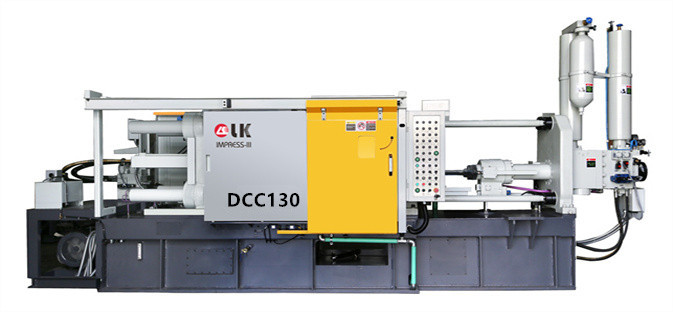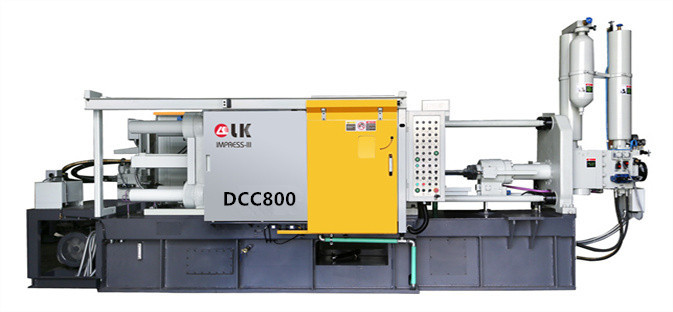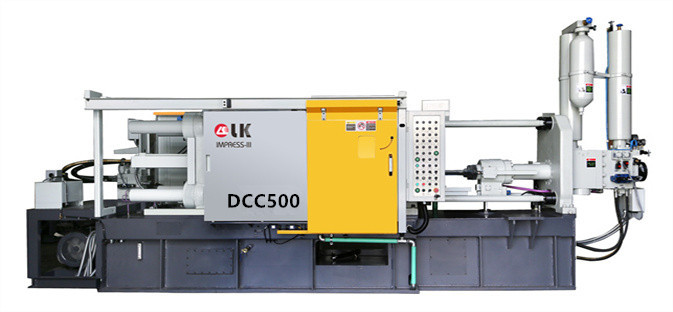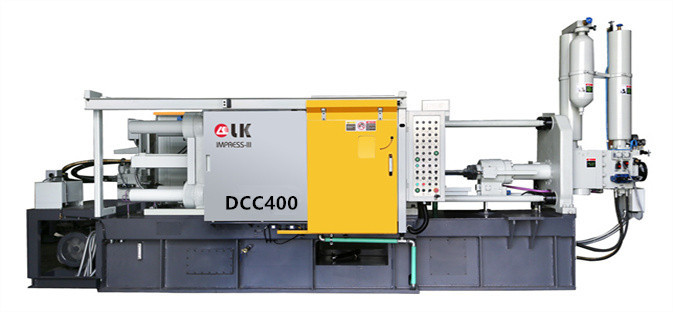Research on Deformation and Oil Cooling of Shot Sleeve in High-Pressure Die Casting
LK Die Casting Machine / 2024-07-05 14:32:17
High-pressure die casting is a process commonly used to manufacture complex and precise metal parts.
During the high-pressure die-casting process, the shot sleeve (i.e., the key component in the die-casting machine) is affected by high temperature, high-pressure
and high-speed movement, and is prone to deformation, which in turn affects the quality and production efficiency of the casting.
In order to reduce the deformation of the shot sleeve and ensure the stability of production and product quality, it is particularly important to study the
application of oil cooling technology in the cooling of the shot sleeve.
This article will discuss in detail the causes of deformation of the shot sleeve in high-pressure die casting, the application of oil cooling technology, and its
impact on the die-casting process.

Introduction to high-pressure die casting process
High-pressure die casting is to rapidly inject molten metal into the mold under high pressure, and obtain a metal casting with a precise shape after cooling and
solidification.
The die-casting process includes the following main steps:
1. Metal smelting: heating the metal or alloy to the melting point to form a molten state.
2. Injection: injecting molten metal into the mold under high pressure.
3. Cooling and solidification: the molten metal cools and solidifies in the mold to form a casting.
4. Demolding: opening the mold, taking out the casting, and performing subsequent processing.
In the die-casting process, the shot sleeve is a key component for injecting molten metal, and its performance directly affects the quality and production
efficiency of the casting.

Causes of deformation of the shot sleeve
The shot sleeve is affected by many factors during the working process and is prone to deformation. The main reasons include:
1. Effect of high temperature: The high temperature of the molten metal will cause thermal expansion and softening of the shot sleeve material, which is prone to
deformation.
2. High-pressure effect: The strong pressure during high-pressure injection will produce mechanical stress on the shot sleeve, causing deformation.
3. Friction and wear: The friction and wear between the shot sleeve the injection cylinder and the molten metal will aggravate the deformation.
4. Material fatigue: Long-term high temperature and high-pressure working environment will cause fatigue of the shot sleeve material, and then deformation.
The deformation of the shot sleeve will lead to a decrease in the dimensional accuracy of the casting, poor surface quality, and may even cause the die-casting
machine to fail, affecting production efficiency and cost.
Therefore, controlling and reducing the deformation of the shot sleeve is an important topic in the die-casting process.
Application of oil cooling technology
In order to effectively control the temperature of the shot sleeve and reduce its deformation, oil cooling technology is widely used in high-pressure die casting.
Oil cooling technology absorbs the heat of the shot sleeve by circulating cooling oil, keeping it within the appropriate temperature range, thereby reducing
thermal expansion and deformation.
The oil cooling system mainly includes the following parts:
1. Cooling oil: Cooling oil with good thermal conductivity and thermal stability, is used to absorb and conduct heat.
2. Oil pump and pipeline: used to transport and circulate cooling oil so that it can continuously absorb the heat of the shot sleeve.
3. Heat exchanger: transfers the absorbed heat to the cooling medium (such as water or air) to reduce the temperature of the cooling oil.
4. Temperature control system: monitors and adjusts the temperature of the cooling oil to ensure that the shot sleeve works within the optimal temperature range.
The application of oil cooling technology in high-pressure die casting has the following advantages:
Efficient cooling: The oil cooling system can absorb and conduct heat quickly and efficiently, keeping the temperature of the shot sleeve stable.
Reduced deformation: By controlling the temperature, reducing thermal expansion, and material softening, the risk of deformation of the shot sleeve is reduced.
Extended life: Reduce thermal and mechanical stress, reduce material fatigue and wear, and extend the service life of the shot sleeve.
Improve quality: A stable temperature environment helps to improve the dimensional accuracy and surface quality of castings and reduce defects.

Experimental research and result analysis
In order to verify the effect of oil cooling technology in high-pressure die casting, experimental research can be carried out.
The experiment usually includes the following steps:
1. Experimental preparation: Select suitable shot sleeve materials and cooling oil, and build an oil cooling system.
2. Temperature monitoring: Install temperature sensors at different positions of the shot sleeve to monitor temperature changes in real time.
3. Deformation measurement: Measure the deformation of the shot sleeve by precision measuring instruments.
4. Data analysis: Compare the temperature and deformation data before and after the oil cooling system is turned on to analyze the oil cooling effect.
Experimental results
The experimental results show that oil cooling technology can significantly reduce the temperature fluctuation of the shot sleeve and reduce its deformation.
The specific data are as follows:
1. Temperature control: The oil cooling system can control the temperature of the shot sleeve within the set range and reduce high-temperature fluctuations.
2. Deformation: After the oil cooling system is turned on, the average deformation of the shot sleeve is reduced by more than 50%, and the deformation peak is reduced
by more than 70%.
3. Casting quality: After using the oil cooling system, the dimensional accuracy and surface quality of the casting are significantly improved, and the defect rate is
reduced by more than 30%.
Discussion and Analysis
The experimental results show that the application effect of oil cooling technology in high-pressure die casting is significant, which can effectively control the
the temperature of the shot sleeve, reduce its deformation, and improve the quality of castings.
The specific analysis is as follows:
1. Temperature stability: The oil cooling system can quickly absorb the heat of the shot sleeve, keep its temperature stable, reduce thermal expansion and material
softening, and reducing the risk of deformation.
2. Mechanical stress: The oil cooling system reduces thermal and mechanical stress by lowering the temperature, thereby extending the service life of the shot sleeve.
3. Production efficiency: Oil cooling technology can improve the stability and reliability of the die-casting process, reduce downtime and maintenance costs, and
improve production efficiency.

Conclusion
The deformation of the shot sleeve in high-pressure die casting is an important factor affecting the quality and production efficiency of castings.
By studying the application of oil cooling technology, the temperature of the shot sleeve can be effectively controlled, its deformation can be reduced, and the
dimensional accuracy and surface quality of the casting can be improved.
The experimental results show that oil cooling technology can significantly reduce the temperature fluctuation and deformation of the shot sleeve, extend its
service life, and improve production efficiency and product quality.
In the future, with the development and application of oil cooling technology, the die-casting process will further improve stability and accuracy, and promote the
progress and development of the manufacturing industry.
At the same time, by optimizing the oil cooling system design and material selection, the cooling effect and system reliability can be further improved, which will
provide stronger technical support for the die-casting process.
Contact LK Egypt to learn more info about the die-casting machine
LKAGENT OFFICE DCM
Address: Industry Zone, South of Port Said Kebly, Egypt
https://www.zazdiecasting.com/
Phone: +86 13598704163
Mobile: +20 101 304 3317 +20 150 181 8310
Email: jack@zazmae.com ahmedmahmoud@zazmae.com
#die cast tooling
#trivalent chromate
#rapid prototype casting
#a360 aluminum
#aluminum caster
#aluminum prototype
#ideal 55 slider parts
#density of aluminum kg/mm3
#magnesium sheet metal
#parts of a metal gate
#subcontracting of screw machining for the luxury sector
#wall aluminum
#die casting tooling
#tooling for die casting
#density of aluminium in kg mm3
#clear chromate
#es casting metals
#gating material
#prototype aluminum
#sigma castings
#subcontracting of screw-machining for household appliances
#we squeeze to please machine
#aluminium gravity die casting
#aluminum part
#aluminum rapid prototyping
#nickel casting
#plunger tip for die casting machine
#rapid prototyping aluminium
OTHER CONTENT
-

2024-09-19 14:16:15 LK Cold Chamber Die Casting Machine DCC900 Locking Force: 9000KN Die Height: 400-1000mm Space Between Tie Bars: 930x930mm Shot Weight: 13.5Kg Casting Area Max:2250c㎡
More -

2024-09-19 14:11:06 LK Cold Chamber Die Casting Machine DCC280 Locking Force: 2800KN Die Height: 250-650mm Space Between Tie Bars: 560x560mm Shot Weight: 2.9Kg Casting Area Max:700c㎡
More -

2024-09-19 10:23:07 LK Cold Chamber Die Casting Machine DCC580 Locking Force: 5000KN Die Heigh: 350-850mm Space Between Tie Bars: 760x760mm Shot Weight: 6.9Kg Casting Area Max:1250c㎡
More -

2024-09-19 10:11:20 LK Cold Chamber Die Casting Machine DCC400 Locking Force: 4000KN Die Height: 300-700mm Space Between Tie Bars: 669x669mm Shot Weight: 4.7Kg Casting Area Max:1000c㎡
More

